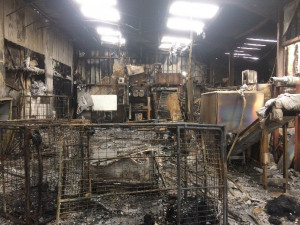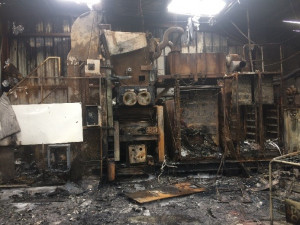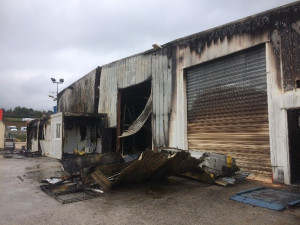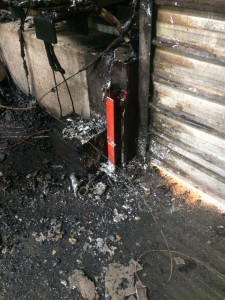At around 1:00 a.m., a fire broke out in a 600 m² building at a collection and pre-treatment (heat sterilisation) facility for potentially infectious medical waste (PIMW). The smoke was noticed by a driver who had come to pick up his truck. He attacked the fire with extinguishers, but the flames spread quickly. Firefighters arrived with hoses and removed the waste skips from inside the building. One was mildly sickened by the smoke.
The building’s firewater containment systems (barriers to be placed across all doorways) were not put in place because no employees were present when the fire started. The heat of the flames subsequently made it impossible to use them (they were found melted after the fire was put out). The plug for isolating the building’s water drainage system from the sewer system was not fitted. The drain ports were left open as a matter of course, allowing 200 m³ of firewater to flow out of the site.
Due to the type and amount (6 t) of waste in the building, the risk of biological contaminants being released to the environment was considered. However, no radioactive medical waste or cytotoxic products were inside the building when the fire happened. The overall contamination level of the PIMW was no higher than that of household waste. The risk of water contamination was therefore managed as for any pollution from waste. The bed of the Vèze, a stream located 100 m from the plant, was inspected. However, no visually detectable consequences were observed. For eight days the operator visually monitored the Vèze along a stretch extending 200 m downstream of the plant. Water and soil samples were collected and tested in the Vèze and the field next to the plant.
The plant’s offices and the main building’s technical facilities were virtually destroyed. The site serves as the company’s head office. The computer hardware used to schedule pick-ups (server room) were also destroyed. The collection and treatment of PIMW was severely impacted. The fire resulted in the temporary layoff of 30 of the plant’s employees. In the following days, all 130 of the group’s employees around the country were also temporarily laid off.
The plant was prohibited from resuming operations until the safety report was revised to take account of the accident. During the rebuilding of the plant, the operator:
- put in a retention pond equipped with a check valve that is accessible and operable at all times;
- installed an automatic fire detection and suppression system;
- now conducts regular fire exercises with firefighters.
Although the periodic checks had not found any malfunctions, an electrical problem emerged as the most likely cause because the driver stated that the fire was coming from an electrical cabinet in the compressor room.








